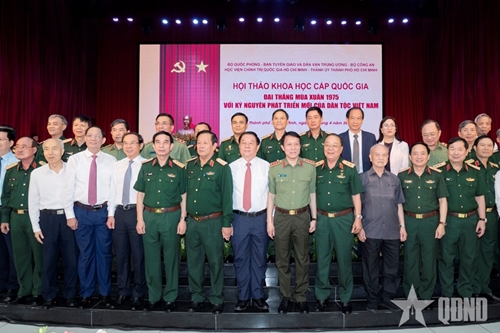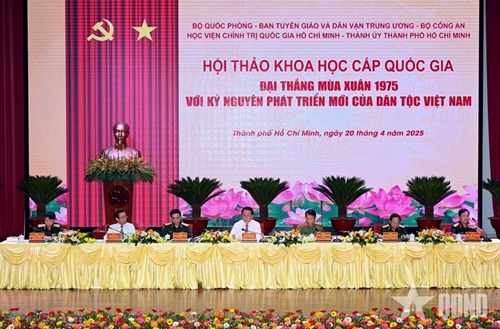The conference, organized by the Ministry of National Defense in collaboration with the Central Commission for Information, Education and Mass Mobilization, the Ministry of Public Security, the Ho Chi Minh National Academy of Politics, and Ho Chi Minh City’s Party Committee, was an important event in the series of activities to commemorate the 50th anniversary of the South Liberation and National Reunification Day (April 30, 1975 - 2025).
    |
 |
|
Delegates pose for a joint photo at the conference. |
The rightful and creative leadership of the Party
Fifty years ago, under the brilliant leadership of the Vietnam Workers’ Party (now the Communist Party of Vietnam), the entire Vietnamese people and armed forces, with unwavering determination, intelligence, creativity, and resilience, achieved the Great Spring Victory in 1975, liberating the South and reuniting the country. To continue affirming the historical significance, heroic achievements, and era-defining scale of the Great Spring Victory in 1975, and to extract lessons from this victory, Defense Minister General Phan Van Giang emphasized at the opening speech that the results of this seminar would contribute to fostering patriotism, national pride, and reinforcing the trust and political determination of the entire Party, people, and military in successfully implementing the Party’s Resolution from the 13th Congress; while combating erroneous and hostile viewpoints that deny the long-lasting resistance war of the nation and the great revolutionary cause of the people. This seminar continued to affirm and deepen the historical significance of the Great Spring Victory in 1975, drawing lessons to apply in the cause of building and securely defending the Socialist Republic of Vietnam in the new development era of the nation, pursuing peace, independence, democracy, prosperity, civilization, happiness, and socialism.
The conference was held in Ho Chi Minh City, where the prolonged resistance war of Vietnam began and where the decisive strategic battle - the historic Ho Chi Minh Campaign took place, ending the 30-year revolutionary struggle. With this meaning in mind, in his welcoming speech, comrade Nguyen Van Nen emphasized that from this important conference, Ho Chi Minh City would undoubtedly gain deep insights that will further enrich the heroic revolutionary tradition, increase awareness of the values of independence and freedom, and foster respect for and preservation of the results the forefathers have tirelessly built over generations.
Over time, the value of the Great Spring Victory in 1975 has been continuously affirmed, becoming a symbol of the will to fight, the determination to win, the indomitable spirit, and the aspirations for peace and independence of the entire Vietnamese people. In the keynote address, comrade Nguyen Trong Nghia stated that the participants should focus on analyzing and explaining more clearly the schemes and tactics of American imperialism and the Saigon puppet regime; deepening the Party’s correct and wise direction; reaffirming that the Great Spring Victory in 1975 was a result of Vietnam’s power in the Ho Chi Minh era; analyzing the distinct characteristics of Vietnamese military strategy and tactics during the resistance war against the American invaders.
Through more than 120 in-depth scientific and accurate presentations , the Great Spring Victory in 1975 was gloriously recalled. Senior Lieutenant General Le Huy Vinh affirmed that the Great Spring Victory in 1975 marked a historic milestone in Vietnam’s development process, one of the most outstanding successes in the Party’s strategy. It was a strategy of seizing opportunities, making timely and precise decisions, and directing the resistance war strategically with flexibility and creativity.
The power of unity and indomitable will
In his speech, Major General Dang Van Hung, former Deputy Commander, Chief of Staff of Military Region 7, stated that before the liberation of Saigon-Gia Dinh, the armed forces of Military Region 7 developed rapidly. By April 1975, the Military Region’s forces numbered nearly 15,000, an increase of 3,000 from the end of 1974. The Saigon-Gia Dinh military command had two regiments and five battalions. Inside the city, the Saigon Party Committee mobilized 72,000 civilians, 233 self-defense teams, and 179 political organizations in preparation for the uprising. This development was attributed to unity and indomitable will, which created strength for the strategic decisive battle.
    |
 |
|
Mr. Nguyen Trong Nghia (center), Head of the Central Commission for Information, Education and Mass Mobilization chairs the conference |
As a direct participant in the Ho Chi Minh Campaign, Major General Nguyen Ngoc Doanh, former Deputy Political Commander of Army Corps 4 (now Army Corps 34), shared that in the Ho Chi Minh Campaign, Army Corps 4 was tasked with raising the flag at the Independence Palace and executing three thrusts in the East and Southwest of Saigon. With high determination, all fronts rapidly attacked and occupied targets according to the plan, excellently completing the mission to liberate Saigon.
The result of the Ho Chi Minh Campaign was the harmonious blend of force and conditions, material and spiritual strength, and close coordination between domestic and international forces. Addressing this issue, the report presented by Colonel, MSc. Vu Vinh Nghiem and Major, MSc. Le Minh Nam from the Institute of Strategy and History of National Defense of Vietnam stated that the resistance war against the American invaders garnered both material and spiritual support of the international community, creating the necessary and sufficient conditions for the Vietnamese people to fight and win. This support was manifested in the help from socialist countries, the progressive movements in the U.S. and around the world opposing the Vietnam war, and the solidarity of the three Indochinese countries.
In response to the call of the Party and President Ho Chi Minh, the entire Vietnamese people formed a solid, unified block in both awareness, will, and action; unity within the Party, unity among the people, and unity from the North to the South, as well as international solidarity. Thanks to this, the entire Party, people, and military in both the North and South overcame difficulties and defeated the imperialist American war tactics and the puppet regime. Many discussions deepened the lesson of utilizing total power to create the Great Spring Victory in 1975, pointing out the strength from political, spiritual factors, military culture, unity, and aspirations for peace. They also emphasized the mobilization of the entire people, from all classes and groups, to participate in the General Offensive and Uprising in the Spring of 1975 to achieve complete victory.
Creative application in the new era
The results of the Great Spring Victory in 1975 continue to affirm the importance of unity, relying on the people, and ensuring their welfare. This is the core message of the speech by Lieutenant General, Prof. Dr. Tran Vi Dan, Member of the Central Theoretical Council, Director of the Science, Strategy, and History Department under the Ministry of Public Security. According to him, the people’s heart and the firm people's heart posture, built under the wise leadership of the Party through grassroots level movements, became the decisive factor in achieving the goal of liberating the South and reunifying the country.
Similarly, the importance of unity was emphasized by former Chairman of the Central Committee of the Vietnam Fatherland Front Huynh Dam, who expressed that the Great Spring Victory in 1975 stemmed from the wise leadership of the Party, the strength of the military, and the unity of the entire nation. The lesson of unity was vividly demonstrated in the resistance war against the American invaders, which was unity among the people, unity among the entire nation, unity from the North to the South, and international solidarity in the spirit of promoting the role of the Vietnam Fatherland Front. This is a profound lesson to be applied in the new development era of the nation.
Through theoretical and practical work on Party and political affairs, in his speech to the seminar, Senior Lieutenant General Trinh Van Quyet underlined that the victory of the General Offensive and Uprising in the Spring of 1975 marked a decisive turning point, ushering the Vietnamese people into an era of independence, reunification, and socialism, while leaving valuable lessons. “In the national defense and construction cause, we must place special emphasis on constructing a balanced and unified military force; building a revolutionary, regular, elite, modern Vietnam People’s Army, strong in political ideology, ethics, organization, and personnel, ensuring the military is a loyal and reliable force for the Party, State, and people in the mission of protecting the Socialist Republic of Vietnam”, said Senior Lieutenant General Trinh Van Quyet.
In his concluding speech, General Luong Tam Quang praised the scientific depth of the presentations and stressed that the seminar clarified the role and value of new materials that need to continue being gathered and researched for practical applications. It is necessary to continue widely disseminating the contents and outcomes of this conference to contribute to teaching history, igniting patriotism, and promoting the love for the country among officials, troops, and citizens in the country, and overseas Vietnamese, especially for the younger generation, so that they truly understand the historical value of the Great Spring Victory 50 years ago. Half a century has passed, but the heroic hymn of the Great Spring Victory in 1975 continues to resonate in the hearts of generations of Vietnamese people. This hymn has contributed to affirming the strength, intelligence, and aspiration for self-reliance of Vietnamese people as they confidently step into the new era.
Translated by Minh Anh